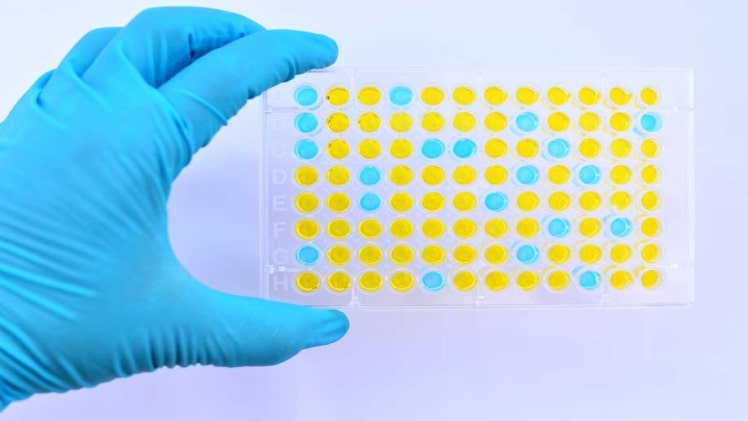Enzyme-linked immunosorbent assays (ELISAs) are used for a wide variety of research and diagnostic applications due to their versatility, ease of use, and ability to detect multiple targets. ELISA allows researchers to quantitatively detect the presence of an antigen within a biological sample. There are four main types of ELISA, classified based on their use of enzymes and the specific binding that occurs between the target antigen and the raised antibody: direct, indirect, sandwich, and competitive. Each type features its own distinct set of advantages and disadvantages that make it more suitable for specific applications than the other types.
1. Direct ELISA
Direct ELISA is the standard version of ELISA and is much simpler and faster to perform than other types because it requires limited steps and a minimal number of reagents. In this technique, researchers coat a microplate with the antigen of interest, directly binding it to the immobilized antigen. The enzyme linked to the antibody produces a visible signal that is measured to detect the presence of the antigen. Direct ELISA is less sensitive than other ELISAs due to the absence of signal amplification.
Advantages:
- Quick and simple procedure
- Saves reagents
- Less prone to error
- Offers faster detection than other types
- No risk of cross-reactivity from a secondary antibody
- Ideal for analyzing an immune system response to an antigen
Disadvantages:
- Low specificity
- Low flexibility when selecting a primary antibody
- Reduced sensitivity
2. Indirect ELISA
Indirect ELISA is functionally similar to direct ELISA, but it involves a two-step detection process. Instead of linking the primary antibody to an enzyme, researchers add a secondary enzyme-linked antibody that binds with the primary antibody and produces a visible signal proportional to the amount of the antigen in the sample. This method is highly flexible because the same secondary antibody can be used to label multiple antibodies. It is economical because it requires fewer labeled antibodies, but cross-reactivity can occur between secondary antibodies and bound antigens.
Advantages:
- High sensitivity
- Increased signal amplification
- High flexibility
- Cost effectiveness
- Ideal for quantifying the concentration of a specific antibody in a sample
Disadvantages:
- Time-consuming and labor intensive compared to direct ELISA
- Vulnerable to cross reactivity
3. Sandwich ELISA
Sandwich ELISA requires the use of two antibodies that are specific for different epitopes of the same antigen, referred to as a matched antibody pair. Researchers immobilize the primary antibody to the plate and expose it to a substrate with the antigen of interest. After washing the plate to remove excess unbound molecules, researchers add the secondary antibody, “sandwiching” the antigen between the two antibodies. The primary antibody binds to the antigen, and the secondary antibody binds to the primary antibody, causing an enzyme reaction with the substrate that produces a visible signal. Sandwich ELISAs are the most common type of ELISA, but it is important to use an optimized ELISA kit that has been validated for the specific reaction to avoid cross-reactivity.
Advantages:
- High sensitivity (two to five times more sensitive than direct and indirect ELISA)
- High specificity allows for precise results
- High flexibility
- Does not require purification of the antigen
- Ideal for complex samples
Disadvantages:
- Potential for cross-reactivity between capture and detection antibodies
- Antigen of interest must be large enough for two different antibodies to bind at different epitopes
- More demanding procedure as only monoclonal antibodies can be used in matched pairs
- Finding two antibodies that bind to the same target, recognize different epitopes, and cooperate in a sandwich format can be challenging
- Monoclonal antibodies are more expensive to procure than polyclonal antibodies
4. Competitive ELISA
Competitive ELISA is a variation of the indirect ELISA and measures the concentration of an antigen in a sample via detection of signal interference. Researchers incubate a labeled primary antibody with the antigen of interest to form an antigen-antibody complex, apply this mixture to a microplate that has been pre-coated with the same antigen, then add the sample with an unknown amount of antigen. If the sample contains the antigen, the sample antigen will compete with the reference antigen to bind to the antibody. The more antigen present in the sample, the lower the concentration of the antibody that remains bound to the wells by the reference antigen after washing the plate, and the lower the signal that is generated.
Advantages:
- High sensitivity
- High flexibility
- Less vulnerable to experimental errors than other types
- Requires limited sample processing
- Applicable to crude or impure samples
- Ideal for detecting small antigens in low concentrations that a sandwich ELISA would be unable to detect
- Can use a labeled antigen for detection instead of a labeled antibody
- Other ELISA types can be modified to fit the competitive format
Disadvantages:
- Complex protocol
- Requires the use of an inhibitor antigen
Direct, indirect, sandwich, and competitive ELISAs each feature their own distinct set of advantages and disadvantages that make each suitable for different applications.
Sources:
https://www.moleculardevices.com/applications/enzyme-linked-immunosorbent-assay-elisa
https://www.mybiosource.com/learn/ELISA
https://www.abcam.com/kits/elisa-principle
https://www.cusabio.com/c-20659.html
SEO Guest post more effective to rank google. You may share your blog on imeetzu and news blog newsxpres. Also put your sport related blog on sportsgossip.
To know more Information: meetyou
Read more about this website: chatrad
You should visit this site: newsinsightz

